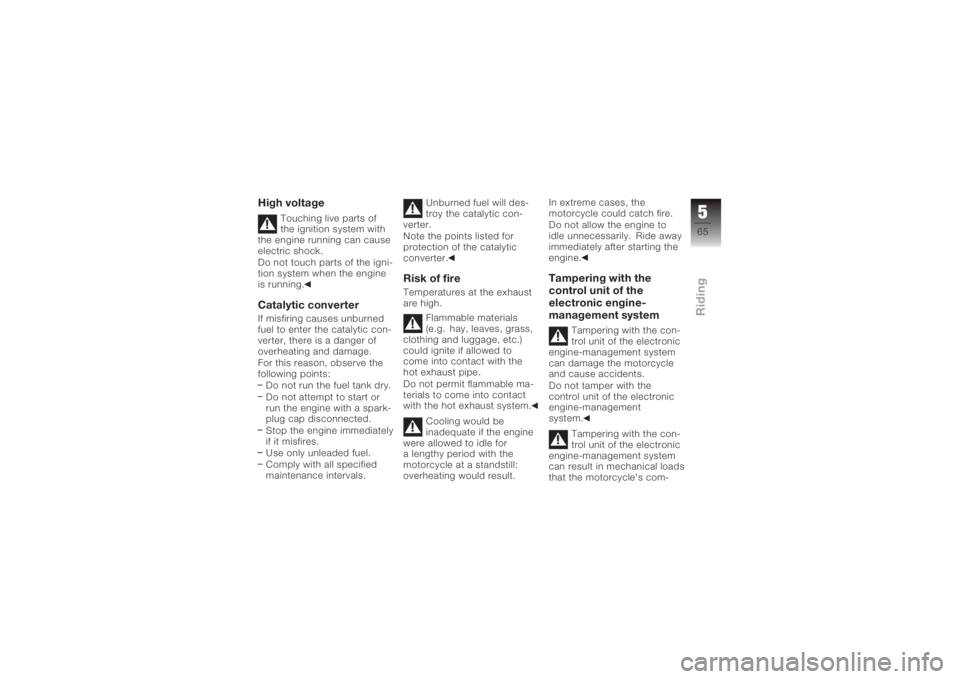Page 26 of 163

Electronic immobiliser
activeGeneral warning light
lights up yellow.
The
EWS!
warning appears
on the display.
The key being used is not au-
thorised for starting, or com-
munication between key and
engine electronics is disrup-
ted.
Remove all other vehicle
keys from the same ring as
the ignition key.
Use the reserve key.
Have the defective key re-
placed, preferably by an
authorised BMW Motorrad
dealer.
Fuel down to reserve General warning light
lights up yellow.
The
FUEL!
warning flashes. Lack of fuel can result
in the engine misfiring
and cutting out unexpectedly.
Misfiring can damage the
catalytic converter; a hazard-
ous situation can result if the
engine cuts out unexpectedly.
Do not run the fuel tank dry.
The estimated residual
range appears on the
display.
The fuel tank contains no
more than the reserve quant-
ity of fuel.
Reserve fuel
4l
Refuelling ( 71)
Coolant temperature too
high General warning light
lights up red. The temperature reading
flashes.
Continuing to ride when
the engine is overheated
could result in engine dam-
age.
You must comply with the in-
structions below.
The coolant temperature is
too high.
If possible, ride in the part-
load range to cool down the
engine.
In traffic jams, switch off the
engine, but leave the igni-
tion switched on so that the
radiator fan continues to op-
erate.
If the coolant temperature
is frequently too high, have
the fault rectified as soon
as possible by a special-
ist workshop, preferably an
authorised BMW Motorrad
dealer.
324zStatus indicators
Page 67 of 163

High voltage
Touching live parts of
the ignition system with
the engine running can cause
electric shock.
Do not touch parts of the igni-
tion system when the engine
is running.
Catalytic converterIf misfiring causes unburned
fuel to enter the catalytic con-
verter, there is a danger of
overheating and damage.
For this reason, observe the
following points:
Do not run the fuel tank dry.
Do not attempt to start or
run the engine with a spark-
plug cap disconnected.
Stop the engine immediately
if it misfires.
Use only unleaded fuel.
Comply with all specified
maintenance intervals. Unburned fuel will des-
troy the catalytic con-
verter.
Note the points listed for
protection of the catalytic
converter.
Risk of fireTemperatures at the exhaust
are high.
Flammable materials
(e.g. hay, leaves, grass,
clothing and luggage, etc.)
could ignite if allowed to
come into contact with the
hot exhaust pipe.
Do not permit flammable ma-
terials to come into contact
with the hot exhaust system.
Cooling would be
inadequate if the engine
were allowed to idle for
a lengthy period with the
motorcycle at a standstill:
overheating would result. In extreme cases, the
motorcycle could catch fire.
Do not allow the engine to
idle unnecessarily. Ride away
immediately after starting the
engine.
Tampering with the
control unit of the
electronic engine-
management system
Tampering with the con-
trol unit of the electronic
engine-management system
can damage the motorcycle
and cause accidents.
Do not tamper with the
control unit of the electronic
engine-management
system.
Tampering with the con-
trol unit of the electronic
engine-management system
can result in mechanical loads
that the motorcycle's com-
565zRiding
Page 75 of 163

readings will not tally with
the readings shown by the
multifunction display.Tyre-pressure rangesThe RDC control unit differ-
entiates between three air-
pressure ranges, all of which
are parameterised for the mo-
torcycle:Air pressure within permit-
ted tolerance.
Air pressure close to limit of
permitted tolerance.
Air pressure outside permit-
ted tolerance.Brake system, generalDescending mountain
passes
There is a danger of the
brakes fading if you use
only the rear brakes when
descending mountain passes.
Under extreme conditions, the brakes could overheat and
suffer severe damage.
Use both front and rear
brakes, and make use of the
engine's braking effect as
well.
Wet brakes
After the motorcycle has
been washed, ridden
through water or ridden in
the rain, the brake discs and
pads might be wet and the
brakes might not take effect
immediately.
Apply the brakes in good time
until the brakes have dried
out.
Salt on brakes
The brakes may fail to
take effect immediately
if the motorcycle was ridden
on salt-covered roads and the
brakes were not applied for
some time. Apply the brakes in good
time until the salt layer on the
brake discs and brake pads
has been removed.
Oil or grease on brakes
Oil and grease on the
brake discs and pads
considerably diminish braking
efficiency.
Especially after repair and
maintenance work, make
sure that the brake discs and
brake pads are free of oil and
grease.
Dirt or mud on brakes
When riding on loose
surfaces or muddy
roads, the brakes may fail
to take effect immediately
because of dirt or moisture on
the discs or brake pads.
Apply brakes in good time
until the brakes have been
cleaned.
573zRiding